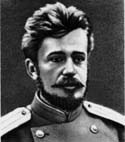Mikhail Mikhailovich Pomorzew
Mikhail Pomortsev ( Russian Михаил Михайлович Поморцев ., Scientific transliteration Mikhail Michajlovič Pomorcev * July 12 . Jul / 24. July 1851 greg. In the village Wassiljewschtschina the government Nizhny Novgorod , † June 19 jul. / 2. July 1916 greg. in Petrograd ) was a Russian balloonist , meteorologist and inventor .
Pomorzew, eldest son of the artillery officer Mikhail Yakovlevich Pomorzew, attended the military high school in Nizhny Novgorod from 1862 to 1868. He then studied at the Artillery School in Saint Petersburg. After completing his training, he was assigned to an artillery brigade in western Ukraine and later transferred to Bessarabia . In 1875 he was assigned to a 6-month course in geodesy at the Academy of the General Staff in Saint Petersburg. Back in Bessarabia, he met 18-year-old Stefanija Lukinitschna Brschostowskaja, whom he married that same year. In 1876 the son Vladimir was born. After further studies at the Academy of the General Staff, Pomorzew was posted to the Pulkovo Observatory in 1878 . In addition to geodesy, he was now mainly interested in meteorology.
In 1880 he returned to Saint Petersburg. In 1882 he got a position at the military medical academy, where he stayed for 17 years and carried out his most important work in the aeronautical and meteorological field. At first he was concerned with the construction of military rangefinders . In 1889 he wrote the weather forecast textbook , one of the first books on synoptic meteorology . In 1891, on the initiative of Pomorzev, the Russian Technical Society carried out three scientific balloon ascents. In 1891 his work Scientific Results from Forty Aviation Flights in Russia appeared , in which he presented vertical profiles of temperature, humidity and wind. The work was awarded the gold medal of the Russian Geographical Society. In consultation with the German meteorologist Richard Assmann , simultaneous scientific balloon flights took place in Berlin (carried out by Arthur Berson ), Saint Petersburg (Pomorzew) and Stockholm ( Salomon August Andrée ) in 1893 . Pomorssev also used pilot balloons and developed devices with which he could calculate the path of the balloon from ground observations. In 1894 he developed a nephoscope to determine the speed and direction of cloud movement . At the World Exhibition in Paris in 1900 Pomorzew was a member of the jury. The French government awarded him the Legion of Honor .
In 1902 Pomorzew gave up practical activity in the field of aerology and turned to flying machines heavier than air . On his initiative, funds were made available for military missile experiments , which he carried out in Saint Petersburg and Sevastopol . Between 1902 and 1905 he tested about 20 different stabilizers to improve the accuracy of the missiles. Its rockets had a range of 8 to 9 km with a mass of 10 to 12 kg.
In 1904 he received a gold medal for his work in the field of meteorology at the International Hygiene Exhibition in Marseille . Pomorssev was now active in very different fields. He developed a parachute and fabric that is impermeable to water but permeable to air . In 1906 Pomorssev gave up rocket experiments, and in 1907 he retired from military service with the rank of major general. Secured by a pension, he continued his research. Through the mediation of Nikolai Jegorowitsch Zhukowskis , Pomorzew worked at the aerospace laboratory in Moscow in 1912 . Here he designed an aircraft with a variable angle of attack of the wings, which he had patented.
Pomorzew died of a heart condition in Petrograd in 1916 and was buried in the Ochta cemetery.
The lunar crater Pomortsev is named after him.
Web links
- Detailed CV on space.hobby.ru (Russian)
- Article Поморцев Михаил Михайлович in the Great Soviet Encyclopedia (BSE) , 3rd edition 1969–1978 (Russian)
- Russian Brockhaus article (1907) about Pomorzew (Russian)
| personal data | |
|---|---|
| SURNAME | Pomorzew, Michail Michailowitsch |
| ALTERNATIVE NAMES | Поморцев, Михаил Михайлович (Russian); Pomorcev, Michail Michajlovič (scientific transliteration) |
| BRIEF DESCRIPTION | Aeronaut, meteorologist and inventor |
| DATE OF BIRTH | July 24, 1851 |
| PLACE OF BIRTH | Vasilyevshchina, Nizhny Novgorod Governorate |
| DATE OF DEATH | July 2, 1916 |
| Place of death | Petrograd |
